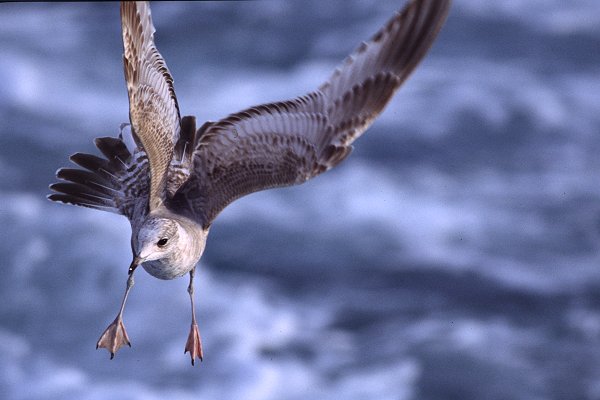
Date: 2003-02-05
Lens: Canon 400mm F5.6

 Mew Gull
Larus canus
Mew Gull
Larus canus
 Description
DescriptionMew Gulls are named for the "mewing" sounds of their breeding calls. Their Latin name, Larus canus, reflects their coloration and means "gray- and white-haired gull". Although this bird is a scavenger like other gulls, it often catches insects, sometimes from swarms in the air.
General: Sexes similar. Fairly short, small bill with indistinct gonydeal angle. 16 to 18 inches in length.
Adult Alternate: White head, neck, breast, belly, and tail. Medium gray back and upperwings. Black primaries with white tips and white line dividing black and gray. Bright yellow bill. Yellow legs. Dark eye. White tertial crescent.
Adult Basic: Similar to adult alternate, except there are brown smudges about the bird's head.
Juvenile: Dark brown plumage. Pale base to otherwise dark bill.
First Year: White head, neck and upper breast streaked with brown. Medium gray back. Brown belly. Black primaries; medium gray secondaries. Dull brown upperwing coverts. Dark tail. Pink bill with black tip. Pink or grayish legs.
European Species: Adult alternate differs in wingtip pattern. First year birds have white tails with sharp black terminal bands.
Coastal shores, mudflats, and ports. Nests along rivers, lakeshores, and seacoasts.
 Nesting
Nesting2-3 brown/olive-buff eggs with brown or black blotches and scrawls. The eggs have a 24-26 day incubation period. Fledging occurs in 30-32 days. The nest is made from grass and built on a beach, riverbank, in a treetop, on a stump, or on pilings. Nests in colonies, and often with other gulls.